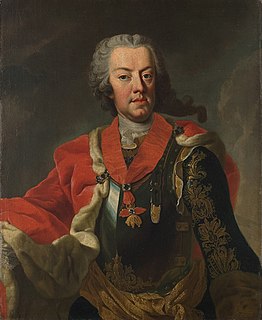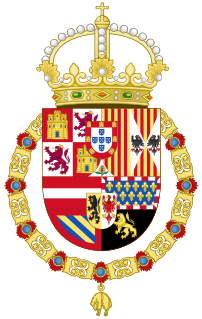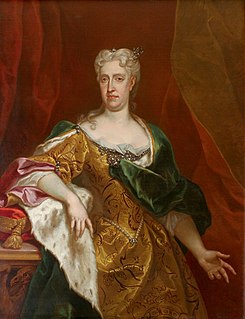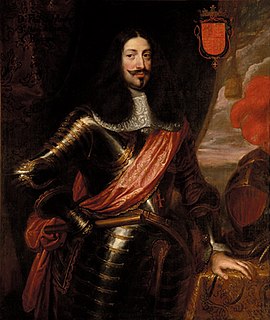 W
WFrancisco Antonio de Agurto y Salcedo, 1st Marquess of Gastañaga was a Spanish nobleman, viceroy and governor of Basque origin. He became first Marquess de Gastañaga in 1676 and was Governor of the Habsburg Netherlands between 1685 and 1692. He led the Spanish troops in the Battle of Fleurus (1690) and unsuccessfully defended Mons against the French. He began a new royal chapel of Saint Joseph in Waterloo in 1687 an attempt to curry favour with the court, but was recalled to Madrid for his failure to hold Mons. After this he became Viceroy of Catalonia between 1694 and 1696, where he was confronted with a French invasion during the War of the Grand Alliance.
 W
WAlbert VII was the ruling Archduke of Austria for a few months in 1619 and, jointly with his wife, Isabella Clara Eugenia, sovereign of the Habsburg Netherlands between 1598 and 1621. Prior to this, he had been a cardinal, archbishop of Toledo, viceroy of Portugal and Governor General of the Habsburg Netherlands. He succeeded his brother Matthias as reigning archduke of Lower and Upper Austria, but abdicated in favor of Ferdinand II the same year, making it the shortest reign in Austrian history.
 W
WPrince Albert Casimir of Saxony, Duke of Teschen was a Saxon prince from the House of Wettin who married into the Habsburg imperial family. He was noted as an art collector and founded the Albertina in Vienna, one of the largest and finest collections of old master prints and drawings in the world.
 W
WFernando Álvarez de Toledo y Pimentel, 3rd Duke of Alba, known as the Grand Duke of Alba in Spain and Portugal and as the Iron Duke in the Netherlands, was a Spanish noble, general and diplomat. He was titled the 3rd Duke of Alba de Tormes, 4th Marquess of Coria, 3rd Count of Salvatierra de Tormes, 2nd Count of Piedrahita, 8th Lord of Valdecorneja, Grandee of Spain and a Knight of the Order of the Golden Fleece. His motto in Latin was Deo patrum Nostrorum.
 W
WCarlos de Aragón de Gurrea y de Borja, 9th duke of Villahermosa was a Spanish nobleman, viceroy and governor.
 W
WPrince Charles Alexander Emanuel of Lorraine was a Lorraine-born Austrian general and soldier, field marshal of the Imperial Army, and governor of the Austrian Netherlands.
 W
WArchduke Charles Louis John Joseph Laurentius of Austria, Duke of Teschen was an Austrian field-marshal, the third son of Emperor Leopold II and his wife, Maria Luisa of Spain. He was also the younger brother of Francis II, Holy Roman Emperor. Despite being epileptic, Charles achieved respect both as a commander and as a reformer of the Austrian army. He was considered one of Napoleon's more formidable opponents.
 W
WEmmanuel Philibert was Duke of Savoy from 1553 to 1580. He is remembered for the Italianization of the House of Savoy, as he recovered the savoyard state following the Battle of St. Quentin (1557) and subsequently moved the capital to Turin and made Italian the official language in Piedmont.
 W
WArchduke Ernest of Austria was an Austrian prince, the son of Maximilian II, Holy Roman Emperor, and Maria of Spain.
 W
WPrince Eugene Francis of Savoy–Carignano better known as Prince Eugene was a field marshal in the army of the Holy Roman Empire and of the Austrian Habsburg dynasty during the 17th and 18th centuries. He was one of the most successful military commanders of his time, and rose to the highest offices of state at the Imperial court in Vienna.
 W
WAlexander Farnese was a Parmese noble and condottiero and later a general of the Spanish army, who was Duke of Parma, Piacenza and Castro from 1586 to 1592, as well as Governor of the Spanish Netherlands from 1578 to 1592. Thanks to a steady influx of troops from Spain, during 1581–1587 Farnese captured more than thirty towns in the south and returned them to the control of Catholic Spain. During the French Wars of Religion he relieved Paris for the Catholics. His talents as a field commander, strategist and organizer earned him the regard of his contemporaries and military historians as the first captain of his age.
 W
WAlessandro Farnese was an Italian military leader, who was Governor of the Habsburg Netherlands from 1678 until 1682.
 W
WCardinal-Infante Ferdinand was Governor of the Spanish Netherlands, Cardinal of the Holy Catholic Church, Infante of Spain, Infante of Portugal, Archduke of Austria, Archbishop of Toledo (1619–41), and military commander during the Thirty Years' War.
 W
WCount Friedrich August von Harrach-Rohrau,, was plenipotentiary minister of the Austrian Netherlands (1732–1741) and became Governor-General ad interim in 1741–1744.
 W
WIsabella Clara Eugenia, sometimes referred to as Clara Isabella Eugenia, was sovereign of the Spanish Netherlands in the Low Countries and the north of modern France with her husband, Archduke Albert VII of Austria. Their reign is considered the Golden Age of the Spanish Netherlands. Isabella was one of the most powerful women in 16th and 17th century Europe.
 W
WJohn of Austria was an illegitimate son of Holy Roman Emperor Charles V. He became a military leader in the service of his half-brother, King Philip II of Spain, and is best known for his role as the admiral of the Holy Alliance fleet at the Battle of Lepanto.
 W
WJohn of Austria or John Joseph of Austria was a Spanish general and political figure. He was the only illegitimate son of Philip IV of Spain to be acknowledged by the King and trained for military command and political administration. Don John advanced the causes of the Spanish Crown militarily and diplomatically at Naples, Sicily, Catalonia, the Netherlands, Portugal, Dunkirk and other fronts. He was the governor of the Southern Netherlands from 1656 to 1659. He remained a popular hero even as the fortunes of Imperial Spain began to decline. His feuds with his father's widow, Queen Mariana, led to a 1677 palace coup through which he exiled Mariana and took control of the monarchy of his half-brother Charles II of Spain. However, he proved far from the savior Spain had hoped he would be. He remained in power until his death in 1679.
 W
WArchduke Leopold Wilhelm of Austria, younger brother of Emperor Ferdinand III, was an Austrian soldier, administrator and patron of the arts.
 W
WLuis Francisco de Benavides Carrillo de Toledo, Marquis of Caracena, Marquis of Fromista was a Spanish general and political figure. He served as Governor of the Habsburg Netherlands between 1659 and 1664.
 W
WArchduchess Margaret of Austria, suo jure Countess of Artois, was Governor of the Habsburg Netherlands from 1507 to 1515 and again from 1519 to 1530. She was the first of many female regents in the Netherlands.
 W
WMargaret of Parma was Governor of the Netherlands from 1559 to 1567 and from 1578 to 1582. She was the illegitimate daughter of the then 22-year-old Holy Roman Emperor Charles V and Johanna Maria van der Gheynst. She was a Duchess of Florence and a Duchess of Parma and Piacenza by marriage.
 W
WArchduchess Maria Anna Eleanor Wilhelmina Josepha of Austria was a member of the House of Habsburg who governed the Austrian Netherlands in the name of her elder sister, Empress Maria Theresa.
 W
WArchduchess Maria Elisabeth of Austria, was the governor of the Austrian Netherlands between 1725 and 1741.
 W
WMary of Austria, also known as Mary of Hungary, was queen consort of Hungary and Bohemia as the wife of King Louis II, and was later Governor of the Habsburg Netherlands.
 W
WMaximilian II, also known as Max Emanuel or Maximilian Emanuel, was a Wittelsbach ruler of Bavaria and a Prince-elector of the Holy Roman Empire. He was also the last governor of the Spanish Netherlands and duke of Luxembourg. An able soldier, his ambition led to conflicts that limited his ultimate dynastic achievements.
 W
WÍñigo Melchor Fernández de Velasco, 7th Duke of Frías, GE, KOS, was a Spanish nobleman and Governor-General of the Spanish Netherlands.
 W
WDom Francisco de Melo was a Portuguese nobleman and general.
 W
WFrancisco de Moncada, 3rd Marquis of Aytona, (1586–1635) was a Spanish diplomat, soldier and writer of the early 17th century. He was also interim Governor of the Spanish Netherlands.
 W
WFrancisco de Moura Corte Real, 3rd Marquis of Castelo Rodrigo was a Portuguese nobleman who served as Viceroy of Sardinia and Governor of the Habsburg Netherlands.
 W
WDom Manuel de Moura Corte-Real, 2nd Marquis of Castel Rodrigo,, , was Governor of the Habsburg Netherlands from 1644 to 1647.
 W
WPeter Ernst I von Mansfeld-Vorderort was an Imperial and Spanish army commander of German origin and Governor of the Spanish Netherlands from 1592 to 1594.
 W
WJuan Domingo Méndez de Haro y Fernández de Córdoba was a Spanish military and political figure. He was the son of Don Luis Méndez de Haro, 6th Marquis of Carpio, Prime Minister to King Philip IV of Spain, and of Doña Catalina Fernández de Córdoba.
 W
WLuis de Requeséns y Zúñiga also known as Luis de Zúñiga y Requeséns was a Spanish politician, soldier and diplomat.